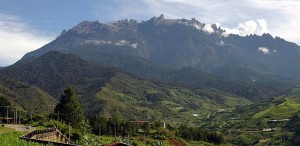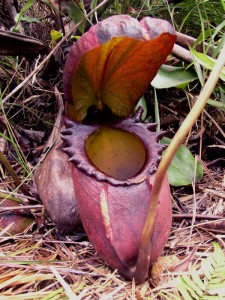Dawn is breaking over Malaysian Borneo and a tired group of climbers have stopped, awestruck by what they can see. Soon they will enthusiastically begin to take photographs of each other and the incredible views from the top of Mt Kinabalu, but for now they are breathless with wonder.
At 4,095 metres they have every reason to be out of breath. This is the highest point in Southeast Asia and they have worked hard over two days to get to the summit plateau of Low’s Peak.

A view of Mt Kinabalu. Pic: Oscark, Wikimedia Commons.
As the sky lightens the views expand across to St John’s Peak, South Peak and the aptly named Donkey’s Ears. Low’s Peak was named after a British colonial officer Sir Hugh Low who first climbed Mt Kinabalu in 1851.
Mt Kinabalu and the surrounding Kinabalu National Park in Malaysia’s Sabah province made the UNESCO World Heritage List thanks to its natural environment.
The lush forests and varied flora and fauna include the world’s largest carnivorous pitcher plant Nepenthes Rajah, some exotic orchids and the largest flower in the world – the metre-wide Raffelesia.

Large lower pitcher of ”Nepenthes rajah”. Pic: NepGrower, Wikimedia Commons.
Kinabalu National Park features lowland tropical rainforest and temperate highlands. Heavy rainfall here has also helped produce an incredible degree of geological diversity with some 6,000 plant species identified in the park, but for most people visiting Kinabalu National Park, reaching the top of the mountain is the ultimate goal.
Climbing Mt Kinabalu is achievable for anyone with a reasonable level of fitness and a spirit of perseverance. You don’t need any previous climbing experience and in fact it is one of the easiest high peaks in the world to conquer.
Setting off from the Timpohon Gate near park headquarters at 1,800 metres, the aim on day one is a bed at a guesthouse at Laban Rata (3,272 metres).
Through magnificent temperate rainforest, past crashing waterfalls and along jungle trails, the first section is the least taxing and fresh water is available from regular rest houses along the path.
Climbers start to feel the altitude after the Layang-Layang rest stop and some easy scrambling over uneven rock is required. The trail has been hacked out of the mountain itself here and climbers bend to grab hold of rocks to pull themselves up the steep terrain.
Soon after this the forest is reduced to scrubby sub-alpine vegetation and then the greenery is left behind altogether. You are over 2,500 metres now so make sure you drink plenty of water as good hydration helps ward off the negative effects of altitude.
After five or six hours walking and climbing the showers and beds at Laban Rata are a welcome end to the first day. However, there isn’t much time for rest. You need to be able to get up very early in the morning to see the sunrise from the top of Mt Kinabalu. How early? Try 1.30am. There is still a lot of ground to cover (in the dark) before the summit.
After an hour-and-a-half climbing seemingly endless by torchlight, you emerge onto the open mountainside.

Summit of Mount Kinabalu. Pic: BluËSky BlÜe, Wikimedia Commons.
Another group of climbers approaching the Low’s Peak summit of Mt Kinabalu have chosen another path to the top. Mt Kinabalu is now home to the world’s highest ‘via ferrata’. Italian for “iron way” a via ferrata is a fixed route of metal ropes, ladders and aerial bridges bolted to a mountain that allows people with no mountaineering experience to reach otherwise inaccessible heights.
Pioneered in Italy’s Dolomite mountains it was based on routes created by soldiers during the First World War. There are now via ferrata routes in many parts of the world but this is the only one in Asia.
There is a two to three-hour beginner’s route and a longer four to five-hour course with an optional summit climb. Qualified guides brief climbers and are available to safely show you the way.
Climbers wear a harness and using special carabineers attach a Y-shaped lanyard between yourself and the gear fixed to the rock. The risks associated with unprotected climbing and scrambling are minimised. If you are fit with a good head for heights, this is the way to the top of Mt Kinabalu for you!
The Mt Kinabalu via ferrata routes offer a chance to see a different side of the mountain from the walkers on the regular trail, and adds a degree of adventure to the ascent.
However they got to the top, all of these climbers feel like they are on top of the world.
After a bite of breakfast there is still a tough four to five hour descent in front of them, but they will always carry this achievement and this view in their hearts.
